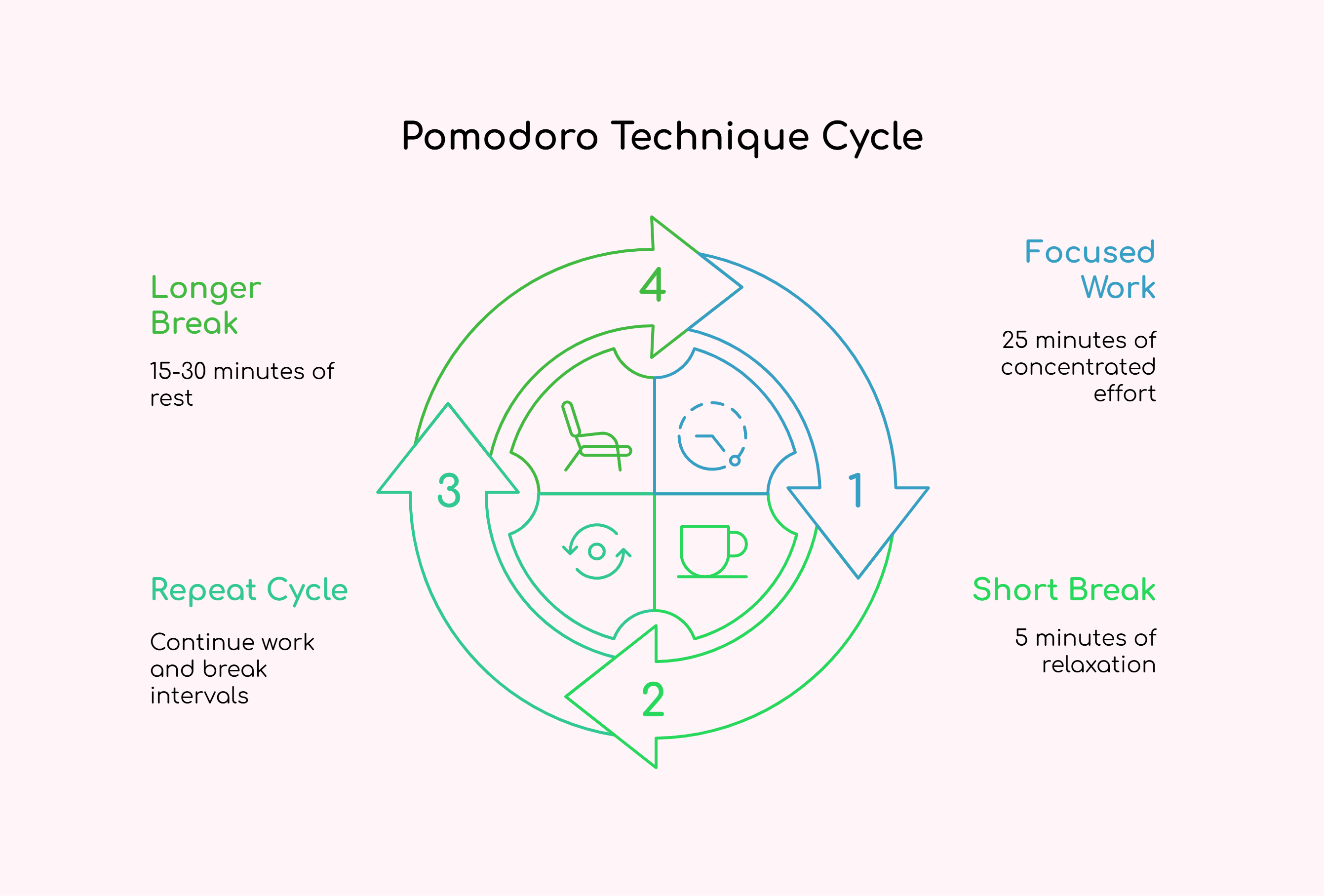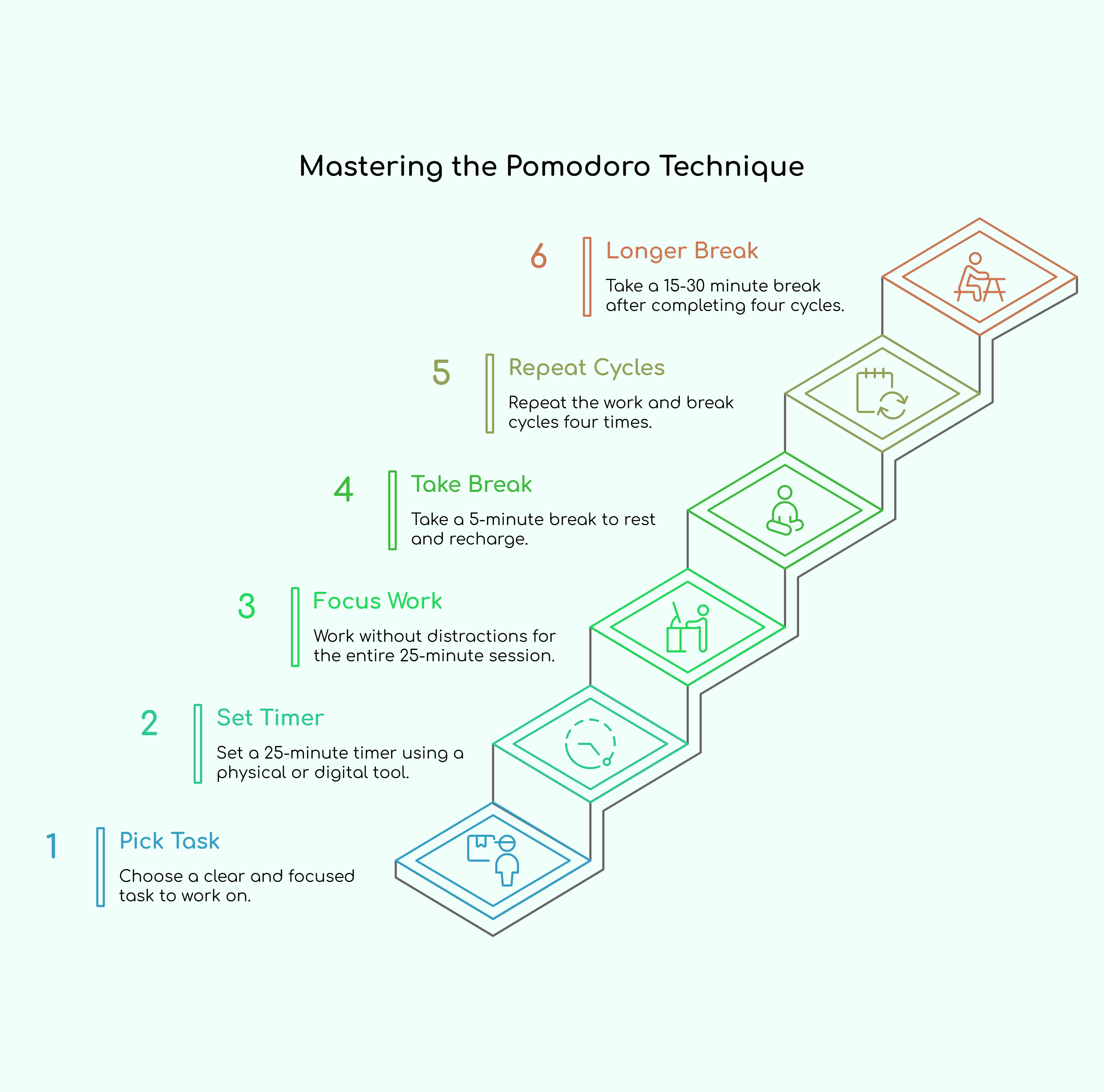Let’s be real—staying focused is hard. Between endless distractions (I’m looking at you, TikTok), overwhelming to-do lists, and that creeping urge to procrastinate, it’s a miracle if we get anything done at all.
Enter the Pomodoro Technique—a ridiculously simple strategy that helped me turn chaos into productivity. Whether you're drowning in study materials, juggling work tasks, or just trying to finish that one book you’ve been "reading" for three months, this method can seriously help.
So, what is the Pomodoro Technique, and how can you actually make it work for you? Let’s dive in.
What is the Pomodoro Technique?
Okay, first things first—what is the Pomodoro Technique?
In short, it’s a time management method where you break your work into 25-minute chunks of laser-focused effort, followed by short 5-minute breaks. After about four of these cycles—called Pomodoros—you treat yourself to a longer 15-30 minute break.
That’s it. Simple, right?
And get this: Pomodoro means tomato in Italian. The guy who invented it literally used a tomato-shaped kitchen timer. (More on that in a sec.)

Here’s the core breakdown:
25 minutes of focused work (“one Pomodoro”)
5-minute short break
After 4 Pomodoros → longer break (15–30 minutes)
You can use a regular kitchen timer or, better yet, a Pomodoro technique app or timer that tracks sessions automatically. Trust me, it makes life easier.
A Quick History of the Pomodoro Method
So, where did this genius idea come from?
In the late 1980s, an Italian university student named Francesco Cirillo was struggling to focus on his studies (relatable, right?). Desperate for a fix, he grabbed his tomato-shaped kitchen timer and challenged himself to study for just 10 minutes.
It worked.
From there, the Pomodoro Technique was born and evolved into the 25/5-minute rhythm we know today. Cirillo later formalized the method, and it spread like wildfire across productivity circles, workplaces, and classrooms. Fast-forward to today, and it’s a global productivity movement with books, courses, and hundreds of Pomodoro technique apps.
Crazy how a tomato timer started all of this.
Who Actually Uses the Pomodoro Study Technique?
Short answer: pretty much everyone.
Whether you’re:
A student cramming for finals,
A remote worker managing your own schedule,
A writer or coder knee-deep in deep work,
Or even someone with ADHD needing that extra structure...
The Pomodoro study technique works because it’s flexible, simple, and keeps your brain happy with frequent breaks.
I’ve seen entire tech teams operate on Pomodoros and students credit it for passing their exams. I personally started using it to beat the “can’t-focus-to-save-my-life” struggle—and it totally worked.
How to Use the Pomodoro Technique to Study Like a Pro (Step-by-Step)
Ready to try it out? Don’t worry—I’ll hold your hand through it. Even if you’ve never used a Pomodoro timer, you’ll have it down in minutes.

Step-by-step Pomodoro Study Guide:
Step 1
Pick your task. Grab your books, notes, or whatever you’re working on. Just make sure it’s clear and focused.
Step 2
Set a 25-minute timer. You can use a physical timer, a Pomodoro technique app, or even a simple Pomodoro timer online. (Tip: Try Forest —more on those later.)
Step 3
Work without distractions. No checking your phone. No side quests. Just focus for 25 minutes, even if it’s tough at first.
Step 4
Take a 5-minute break. You earned it! Stretch, grab a snack, or do a little dance. The goal is to give your brain a rest.
Step 5
Repeat x4. Then longer break. After four Pomodoros (that’s about 2 hours total), take a 15–30 minute break to recharge.
That’s it. Simple, effective, oddly satisfying.
Why Does the Pomodoro Method Work So Well?
Great question—why is this tomato-timer method so powerful?
Here’s the science behind it:
Beats procrastination
The hardest part is starting. But when you only have to commit to 25 minutes, it feels doable. No more “I'll start in 5 minutes”—you JUST start.
Improves focus
When the timer’s ticking, you know it’s game time. Your brain gets into "deep work" mode much faster than usual.
Eliminates burnout
Frequent breaks stop you from frying your brain. You get rest and momentum at the same time.
Tracks progress
Each Pomodoro session is a clear, measurable unit of work. It feels good to say, “I did 6 Pomodoros today.”
Teaches time-awareness
You actually learn how long tasks really take. It’s eye-opening.
Best Pomodoro Technique Apps for Studying (2025 Picks)
Don’t feel like fiddling with a kitchen timer? I’ve got you.
Here are my favorite Pomodoro apps made just for studying and deep work:
Forest (iOS & Android)
Grow a cute little tree while you focus. If you leave the app—your tree dies. It’s weirdly effective (and adorable).
Focus Keeper (iOS)
Minimal, clean, and straight to the point. Great for beginners.
Pomofocus (Web/Desktop)
Free online Pomodoro timer with customizable intervals. I use this one when I’m on my laptop.
Tide (iOS & Android)
Combines Pomodoro timer with nature sounds and productivity stats. Super soothing experience.
Focus To-Do (All platforms)
Pomodoro + task management = Match made in heaven.
Try a few and see what works best for your style. Bonus tip: Pair it with Do Not Disturb mode or a browser blocker if you tend to wander.
The Big Benefits of Using the Pomodoro Technique
So, why should you give this a shot?
Here’s what you can expect from using the Pomodoro method consistently:
Better time management skills (finally!)
Increased productivity without working longer hours
Lower stress levels because you’re not cramming last-minute
Higher focus and less mental fatigue
A clear plan for tackling big tasks, one Pomodoro at a time
More free time because you’re getting stuff done faster
And honestly? It just feels good. It gives you structure without being rigid. It helps you move from reactive to intentional.
Final Thoughts: Is the Pomodoro Technique Right for You?
If you’ve ever found yourself buried under deadlines, distracted every five minutes, or just unsure how to make progress—the Pomodoro Technique might be your new best friend.
It’s not just for students or techies. It’s for anyone who wants to stop spinning their wheels and start working smarter. So grab a timer, try your first Pomodoro, and see how you feel.
Worst case? You waste 25 minutes. Best case? You find a productivity system that actually sticks.
So... ready to crush your goals one tomato at a time?
Let’s go! 🍅